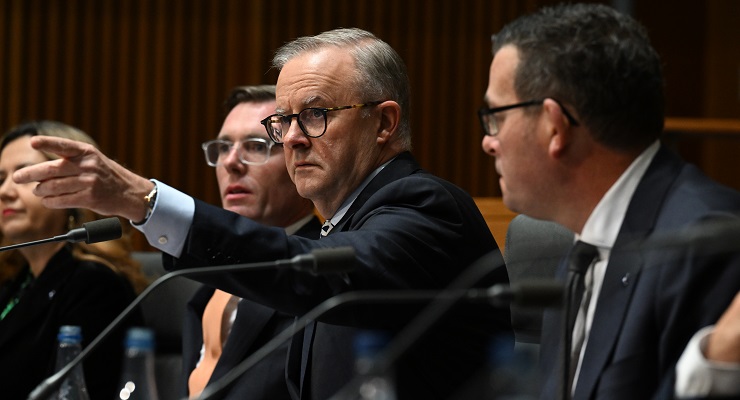
COVID is again tearing through the country, evading immunity from vaccines and previous infections. Australia is recording close to 50,000 cases a day, with a peak expected around late July to mid-August. Most are the BA.4 and BA.5 Omicron subvariants.
Governments should have learned many lessons from the past two and a half years. But have they? It seems not.
On Monday the national cabinet will hold a snap meeting to discuss crisis payments that ended on June 30. Premiers and opposition leaders from New South Wales, Victoria, Queensland, Tasmania and the ACT are calling for the payments to be reinstated, with NSW Liberal Premier Dominic Perrottet saying COVID-19 policies should “never be set and forget”.
Stopping the spread
Victoria’s Health Minister Mary-Anne Thomas has said she disregarded the advice of the state’s chief health officer to mandate masks in retail and early education settings, saying Victorians needed to make their own decisions. Across the country, masks are generally only mandated on public transport and in hospitals or residential aged care, though how compliant the general public is in such cases isn’t clear.
Transmissibility is a major concern: while vaccines, as predicted, have been incredibly successful at limiting severe disease and death, they don’t stop transmission. Given vaccines decrease symptoms, many who have COVID-19 aren’t aware of it.
Free RATs for concession card holders are also coming to an end, as the federal government argues the tests — which have dropped from around $24 a test to $8 — are now affordable enough. But RATs are repeatedly turning up negative results due to low virtual loads while PCR tests turn up positive results.
The timing is questionable: a major issue across the Christmas outbreak was how little data we had on infections as PCR testing sites closed at capacity within minutes of opening, and scarcity of RATs meant no one knew if they were infectious.
Assisting the sick
Antiviral medication is available to Australians aged over 70 who test positive for COVID-19, while those who are severely immunocompromised or have physical or intellectual disabilities can also request COVID-19 treatments. Many immunocompromised people cannot safely have the COVID-19 vaccine.
But the antivirals have been hard to come by, with the federal government announcing yesterday a new “winter plan” for how to handle outbreaks in residential aged care facilities. The plan includes better access to antiviral drugs, but with most of Australia’s deaths occurring among the elderly, it’s not clear why this wasn’t introduced sooner.
Gone too is the protection for casual workers forced to stay home as the virus spreads: the emergency payment ended on July 1, sparking concerns the infectious will continue to work so as to not miss out on a paycheque.
We can predict this
Australia is in a unique position. Thanks to our island isolation and southern hemispheric position, we’re about six months behind outbreaks in Europe, meaning we can look to them to predict waves. But we never have, and this was a major criticism of the government’s pandemic response last winter.
Modelling by Monash University adjunct professor Michael Georgeff compares Australia’s current outbreak with Portugal’s winter outbreak. The countries are epidemiologically comparable by vaccination, previous infection rates and relative population size.

If we’re following Portugal’s lead, Australia is likely to hit 70,000 new daily cases by the end of July — and we’re tracking to have slightly higher rates of hospitalisation at 5500.

Georgeff said the data was simple to calculate. Australia should have known this wave was coming. But as Georgoff tells Crikey, it’s not as serious as it sounds.
“It’s surprising to me that we’re seeing such a little spike,” he said. “We’re socialising as normal, and you would normally expect millions of people to get infected. The fact that we’ve had previous infections, the fact that we’re immunised, is obviously suppressing a lot.”








Governments encounter hurdles. It is part of the job. We elected a new Government in the hope it would perform better (and not be corrupt) but what we see is them falling at every hurdle. Tony Burke has introduced LNP policies to persecute the unemployed and has said that fixing it is all too hard. The Minister in charge of Quarantine is too scared to suspend flights from Bali and apparently cannot get existing controls enforced. And now we have suspension of all the normal things to control the pandemic on the grounds of cost.
It is no good blaming Morrison. His policies can be amended or abolished, in particular his tax cuts which should go back to Parliament. They are unsustainable in the current circumstances. The anti-viral drugs going time-expired in storage could be released to nursing homes. Masks and periods of isolation with pay could be extended.
At every hurdle? No. And would be great if Morrison and Frydenberg hadn’t shovelled money into their mates’ bank accounts.
“..negative results due to low virtual load…”???? Auto correct gone wrong or rushed spell check ? I suspect your brain was thinking about viral loads.
Another case of poor editorial practice and quality control at Crikey. It hasn’t been a good day today.
What really takes the cake is that when entering my comments, your software highlights unknown spelling. Maybe Crikey’s writers should use the same software package.
Thanks for that Paul. I was going to ask what low virtual load is. Now I know why a RAT gives me a negative when I’m definitely positive!
Maybe they do, but virtual is not an unknown spelling.
National Cabinet needs to listen to health advice about masks and crowd restrictions.
Journalism has exploited the pandemic for it’s own purposes and Rupert Murdoch’s Sky after dark is only the very worst example.
Division works.
Apparently there is evidence that the RATS currently available are much less accurate detecting the recent COVID variants. However for some reason I have not heard this used to justify discontinuation of the freebies to concession-holders.